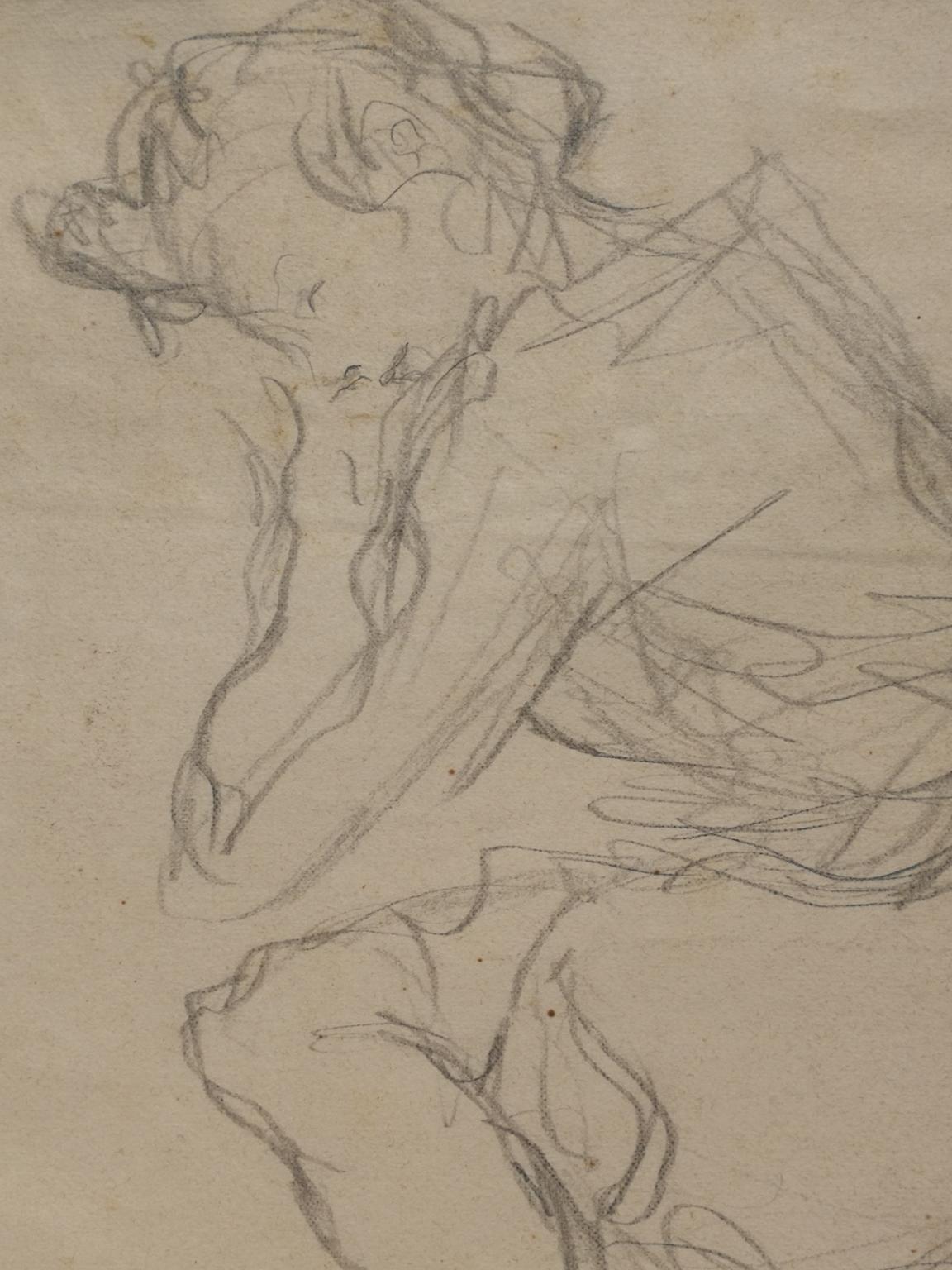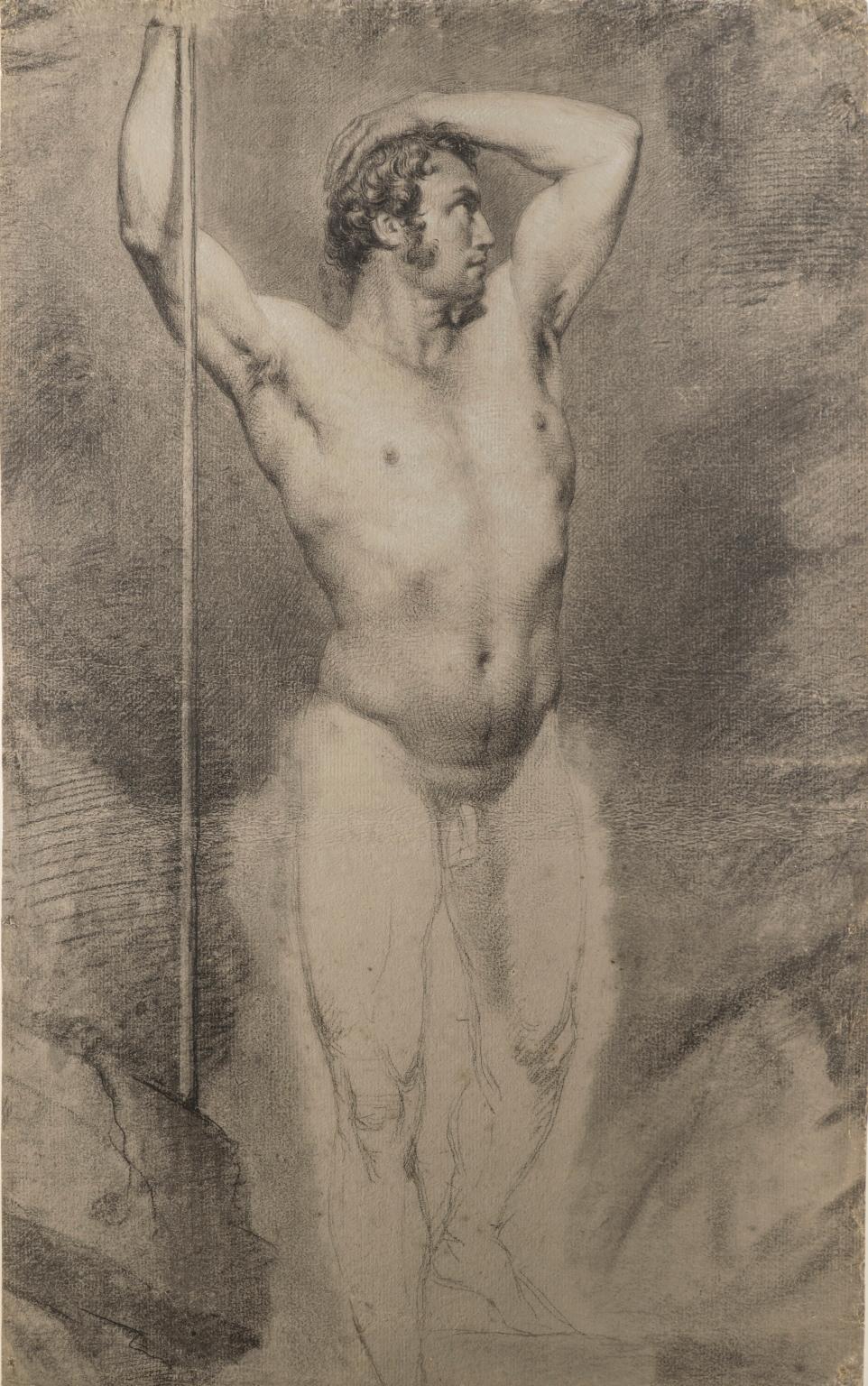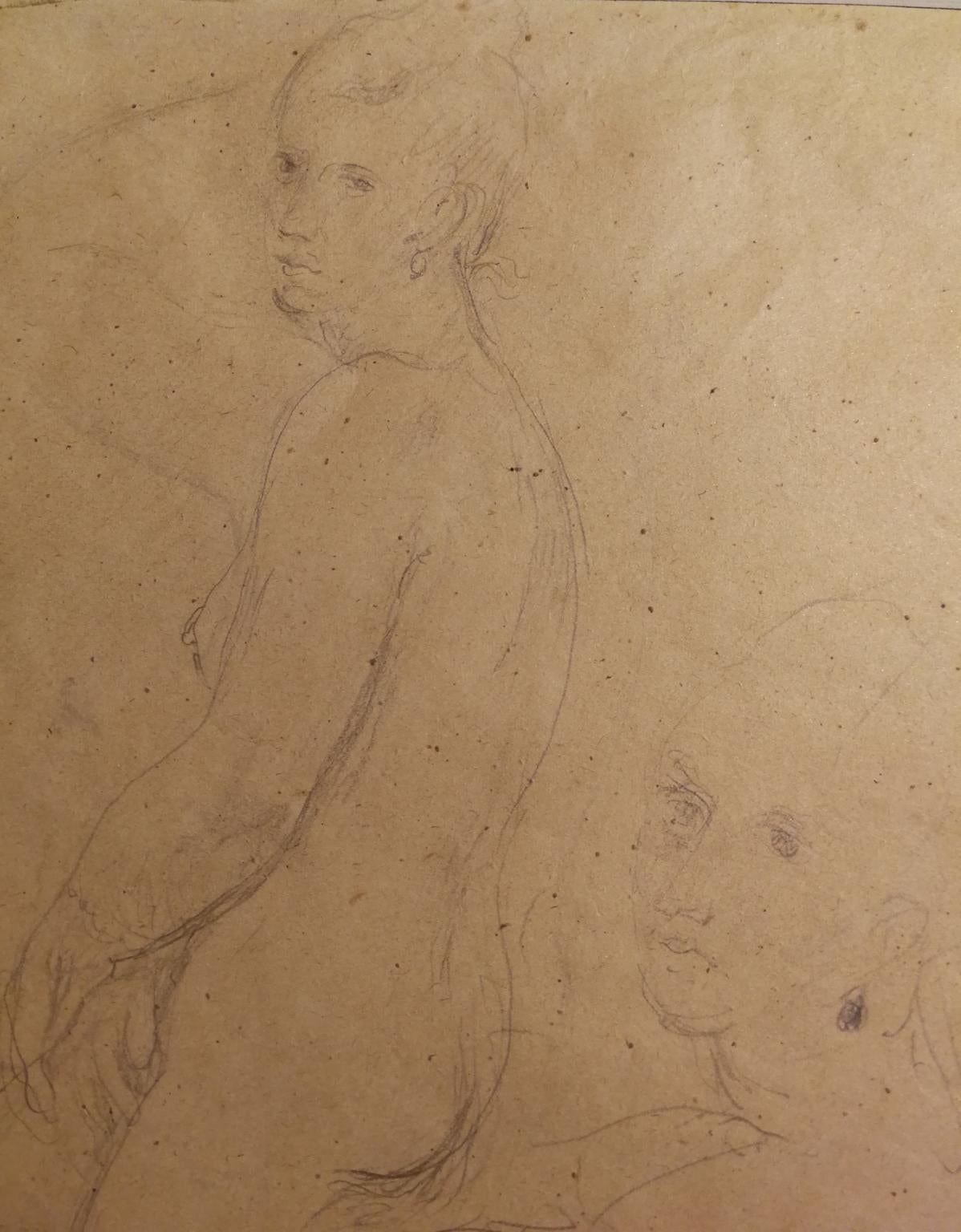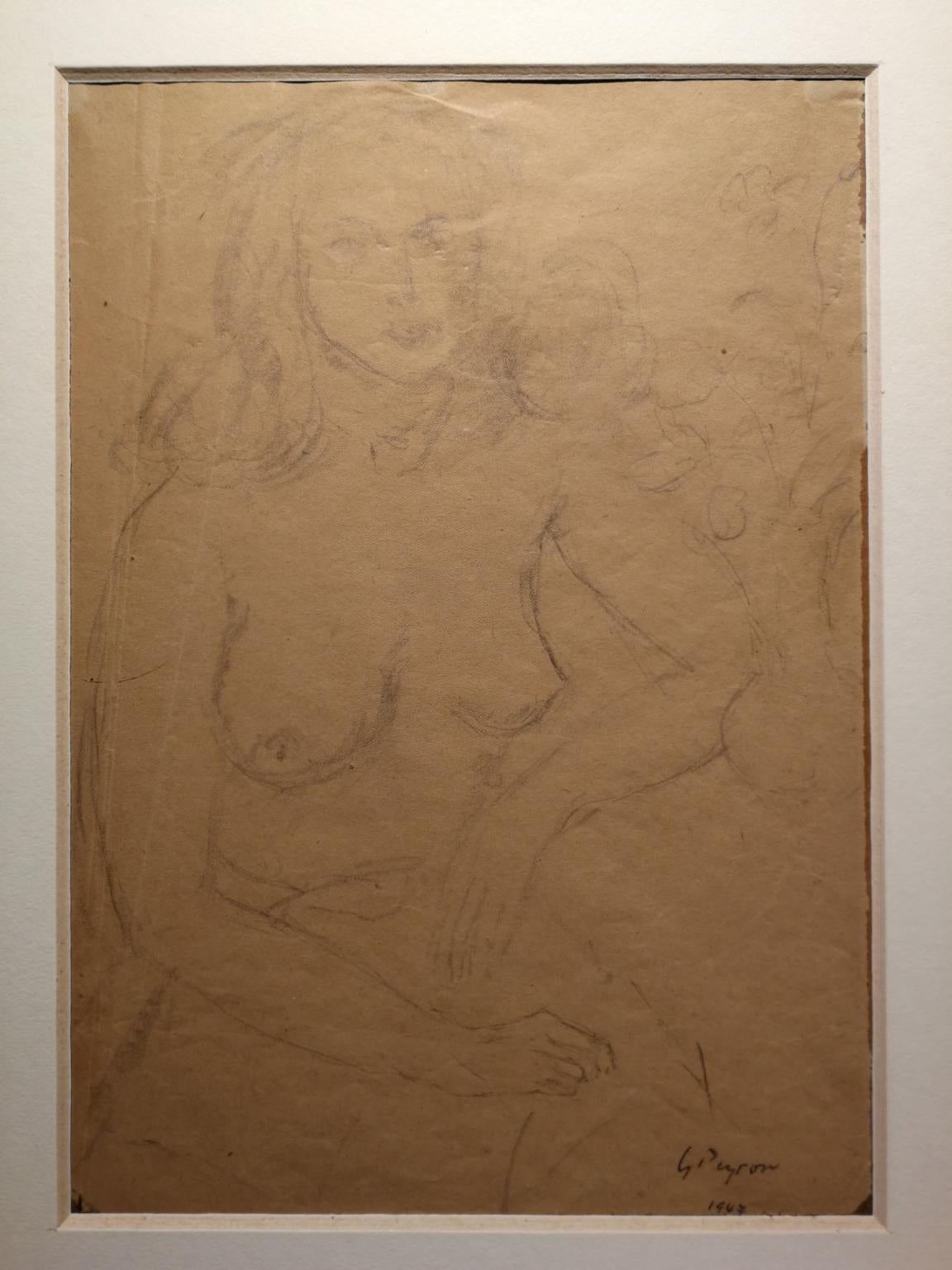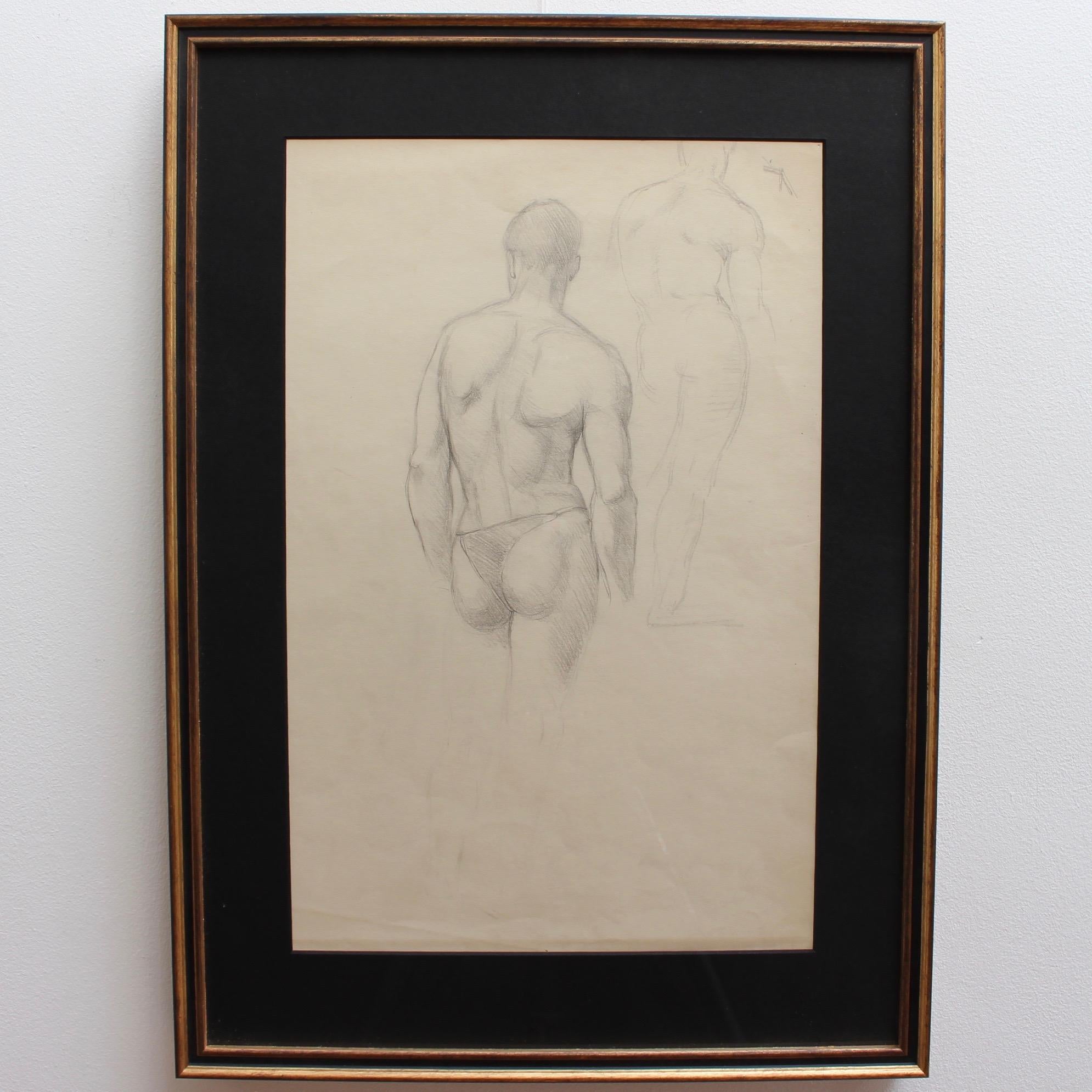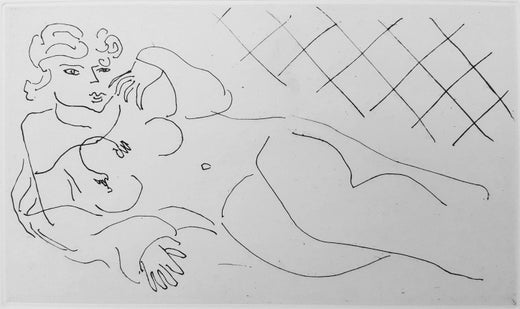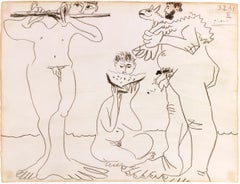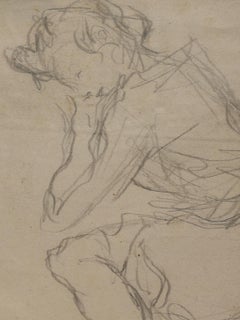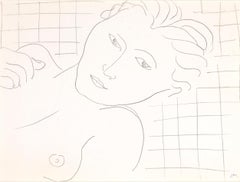
Portrait de femme allongée (Portrait of Reclining Woman)
View Similar Items
Henri MatissePortrait de femme allongée (Portrait of Reclining Woman)Circa 1935
Circa 1935
About the Item
- Creator:Henri Matisse (1869-1954, French)
- Creation Year:Circa 1935
- Dimensions:Height: 18.75 in (47.63 cm)Width: 22.5 in (57.15 cm)
- Medium:
- Movement & Style:
- Period:
- Condition:
- Gallery Location:New Orleans, LA
- Reference Number:Seller: 31-38881stDibs: LU1868703932
Henri Matisse
Whether working as a draftsman, a sculptor, a printmaker or a painter, Henri Matisse was a master of color. Although classically trained at the Académie Julian, in Paris, he quickly abandoned traditional techniques and genres to pioneer a style all his own, marked by quick, gestural strokes and fluid contours.
Along with fellow painter André Derain, Matisse was the leading proponent of Fauvism, a movement whose name is derived from the French word for "wild beast.” Marked by vibrant hues, Fauvist paintings like Matisse’s famous 1906 composition Le Bonheur de vivre use wild, active brushstrokes and a palette unconstrained by nature, resulting in women with purple skin and trees with orange leaves. Often, these compositions unite pure color with the white of exposed canvas to create a sense of transparency and light.
In addition to masterful landscapes and still lifes, Matisse loved to paint erotic subjects, particularly the female nude. Rejecting strict realism, he distilled the form into its essential parts and then translated these into voluptuous, rounded contours. With its striking colors and sculptural modeling of the figure, Odalisque couchée aux magnolias is among Matisse’s most famous works — and the most expensive work of his ever sold — depicting Henriette Darricarrère, his muse and favorite model for around seven years, lounging luxuriously in his Nice studio. In pictures like the lithograph Nu Bleu, he explored the expressive power of a body in motion by placing his figures in twisted or contorted poses, transforming their limbs into tangles of color and shape that push figure painting toward abstraction.
Find original Henri Matisse prints, sculptures and other art on 1stDibs.
- Homme à l'agneau, mangeur de pastèque et flûtisteBy Pablo PicassoLocated in New Orleans, LASigned, dated and numbered “Picasso / 3.2.67 / II” (upper right) Crayon on paper Hailed among the fathers of modern art, Pablo Picasso possessed a seemingly e...Category
20th Century Modern Nude Drawings and Watercolors
MaterialsPaper, Crayon
- Portrait d'homme à lunettes by Tamara De LempickaBy Tamara de LempickaLocated in New Orleans, LATamara De Lempicka 1898-1980 Polish Portrait d'homme à lunettes (Portrait of a Man Wearing Glasses) Signed “Lempicka” (bottom right) Pencil on paper Th...Category
20th Century Art Deco Portrait Drawings and Watercolors
MaterialsPaper, Pencil
- Study for “L’Acropole”By Paul DelvauxLocated in New Orleans, LAPaul Delvaux 1897-1994 Belgian Study for “L’Acropole” Signed and dated "P.Delvaux 1965" (lower right) Watercolor, pen and ink on paper This preliminary drawing for Paul Delvaux’s greatest masterpiece L’Acropole, which resides today in the Centre Pompidou in Paris, features the artist’s most beloved subject — mystical scenes of nude women. A centrally-placed, stoic woman draped in a long green gown stands with her arms outstretched by her sides. She gazes at another idealized woman in the foreground, lying nude on a chaise lounge, while behind her, multitudes of other women in white dresses undertake a long procession towards a distant door. The captivating scene exudes the unique Surrealist style for which the artist has become known. With this skillful rendering of the surreal setting, Delvaux has mastered depicting nude women in a sensual yet non-erotic manner. The artist drew inspiration from a variety of sources, including the futuristic writings of Jules Verne and the mythos of Homer, and blended them with his subconscious themes, which frequently included the nude female form. In combination with the loose concepts of form and perspective found in the 16th-century Mannerist paintings that Delvaux studied in Italy before World War II, his distinctive style served to create memorable dreamscapes without veering into lewdness. Like the very best Surrealist images, the work is both innovative and engaging. Paul Delvaux's earliest and most lasting influences in his art were the futuristic writings of Jules Verne and the mythos of Homer. After completing his initial artistic training at the Académie Royale des Beaux-Arts in Brussels, Delvaux exhibited with Surrealists Dalí...Category
20th Century Post-Impressionist Nude Drawings and Watercolors
MaterialsPaper, Ink, Watercolor, Pen
- Japanese Shunga, Sitting WomanLocated in New Orleans, LAA beautiful example of the Japanese art form known as shunga, this sensual work depicts woman exploring her sexuality. Hand-painted on paper with splashes of vivid gouache color, the...Category
Early 20th Century Other Art Style Nude Drawings and Watercolors
MaterialsPaint, Paper, Gouache
- La femme préhistorique (Prehistoric Woman)By James Jacques Joseph TissotLocated in New Orleans, LAJames Tissot was among the most successful and critically acclaimed artists of the Victorian era. Although the artist is celebrated for his elegant scenes of fashionable life in Paris and London, this work is a fascinating rarity within his oeuvre. In this monumental pastel, Tissot depicts a prehistoric woman draped in a tiger skin, presented with a striking pose and heroic air. His delicate portraiture, combined with his fascination with conveying texture, demonstrates why he was one of the most revered artists of his generation, and La femme préhistorique illustrates the remarkable technique for which he was renowned. This work was completed in preparation for a series of works exploring the Old Testament undertaken by Tissot from 1899-1902 that remained unfinished at the time of his death. A portion of this series focused on illustrations of Adam and Eve, and among these sketches were images of a nude Eve partially draped in animal furs. Towards the end of his life, following his conversion to Catholicism, biblical subjects became important to the artist. A few years before this work was completed, Tissot embarked upon a highly ambitious group of nearly 300 watercolors illustrating the New Testament, presenting the illustrated epic in its entirety at the Paris Salon of 1894. Both of these series were a critical artistic departure for the artist, stemming from a desire to create works separated from his typical images of modern society. This pastel imagines Eve as the prototype of womanhood in the guise of a prehistoric woman. Tissot rarely painted the nude, and his skill as a draftsman highlights the figure's natural beauty, contrasting it with the stark landscape surrounding her. Although a study, this monumental work is incredibly well-finished and highly engaging, with the statuesque model commanding the majority of the canvas. Her pose is strong and theatrical, and she addresses the viewer with a direct, confident gaze. The imagined historical subject of this drawing is grounded by Tissot’s exceptional attention to detail. A master of conjuring an array of textures, Tissot showcased this ability in this work by juxtaposing many types of fabrics and natural elements within one composition. The tiger skin with which the woman partially covers herself was a favorite studio prop of Tissot’s, appearing in many of his most influential works from the period, including several paintings of his partner and favorite model Kathleen Newton. It, in particular, showcases the artist’s understanding of texture, yet it also serves as an exotic element that elevates the sensuality of the scene when placed against the woman’s bare skin. Born in 1836 in the port town of Nantes, Tissot traveled to Paris at the age of 20 in order to join the studios of Hippolyte Flandrin and Louis Lamothe. During this period, he became close with James Abbott McNeill Whistler, Edgar Degas and Edouard Manet, and the impact of these friendships is reflected in his portraits of modern life. Having enjoyed considerable success in Paris during the 1860s, Tissot fought in the Siege of Paris, and after the fall of the Commune in 1871, he went to London, where he stayed for the next ten years. He was met with incredible success there, and he also met the love of his life, Kathleen Newton, a divorcée, with whom he lived from about 1876 until her death in 1882. Today he is regarded among the great masters of Belle Époque painting, and his works can be found in important collections worldwide, including the Metropolitan Museum of Art, the Brooklyn Museum, the National Gallery of Art, the Musée d’Orsay, the Tate Gallery and many others. This pastel remained in Tissot's private collection until his death in 1902 and is referenced in the posthumous 1902-3 valuation of Tissot's home at 64 avenue du Bois...Category
Early 20th Century Academic Nude Drawings and Watercolors
MaterialsLaid Paper, Canvas, Oil Pastel, Pastel
- La femme aux fleurs (Portrait de Mathilde See)By Paul César HelleuLocated in New Orleans, LAPaul César Helleu is regarded among the most sought-after society portraitists of his era, and his Belle Époque works rival those of his contemporaries John Singer Sargent and Giovanni Boldini. He is best remembered for capturing the era's most beautiful socialites, including Consuelo Vanderbilt, the Duchess of Marlborough, the Comtesse de Loriol Chandieu and the Comtesse Mathieu de Noailles, among others. This work, however, stands out in that it captures the charming likeness of one of his art world cohorts, Mathilde See, a Parisian-born decorator and painter of floral still lifes. She is the essence of the modern woman, captured in her fashionable dress as she strolls along the flower-lined streets of Paris. Commanding in size, Portrait de Mathilde See fully displays Helleu's mastery over the medium of pastel. The muted palette of greys and blues is typical of the artist, bringing a harmony and cohesiveness to the composition. Furthermore, Helleu cleverly alludes to See's own artistic output with a backdrop of vibrant floral blooms, enlivening the canvas and complementing the greens and blues of the peacock feather adorning her hat. The portrait is all the more significant thanks to its provenance. It was previously in the collection of A. Alfred Taubman, one of America's most successful entrepreneurs and one-time owner of Sotheby's. Considering Taubman encountered some of the most noteworthy and beautiful works of art ever made through his auction house, the fact that he chose this portrait by Helleu to grace his collection is a testament to its import. Born in Brittany in 1859, Helleu moved to Paris in 1876 in order to study at the École des Beaux-Arts. Like so many other artists of his generation, he was trained there under the Academic master Jean-Léon Gérôme. That same year, he also attended the Second Impressionist Exhibition...Category
20th Century Modern Portrait Paintings
MaterialsLinen, Pastel
- Salimbeni Female Portrait pencil on paper 20th centuryBy Arcangelo SalimbeniLocated in Florence, ITRaffaello Arcangelo Salimbeni, even if he was born in Florence, was raised in Siena by a maternal aunt. He move back to Florence on the 1936, after that the painter Giuseppe Vagnetti...Category
Mid-20th Century Modern Nude Drawings and Watercolors
MaterialsPencil, Paper
- The Roman BathLocated in London, GB'The Roman Bath', pencil on art paper (circa 1960s), School of Rome. Three broad-shouldered men make their way through the sultry corridors of the Hammam in...Category
1960s Modern Nude Drawings and Watercolors
MaterialsPaper, Pencil
$572 Sale Price50% Off - Ritratto di nudo femminile matita su carta firmato e datatoBy Guido PeyronLocated in Florence, ITFigura femminile nuda con i capelli lunghi sciolti, seduta frontale, con accanto un vaso di fiori (matita su carta, 31 x 22 cm) firmato e datato a penna "G. Peyron 1947" . Guido Peyr...Category
1940s Other Art Style Nude Drawings and Watercolors
MaterialsPencil, Paper
- Signed Female Nude Portrait Drawing 20 century pencil paperLocated in Florence, ITThis drawing, pencil on paper 33 x 49 cm without frame, displays a naked woman laying. This is clearely a portrait, by the way she stands and look at the audience. On the back ther...Category
20th Century Other Art Style Nude Drawings and Watercolors
MaterialsPaper, Pencil
- Florentine Male Nude Academia Drawing 19th century pencil paper carved frameLocated in Florence, ITThis drawing, pencil on paper, is an exquisite example of the so called "Academia": study from live of naked figures that was the typical training of the Fine Art Academy in Florence...Category
Early 19th Century Other Art Style Nude Drawings and Watercolors
MaterialsPaper, Pencil
- Mythological pen-on-paper drawing inspired by Annibale Carracci's frescoesBy Annibale CarracciLocated in Florence, ITPen drawing, pencil and sanguine elevations on paper. The subject echoes Annibale Carracci's frescoes at the Palazzo Farnese in Rome (1597-1607), specifically the episode in which H...Category
Early 19th Century Nude Drawings and Watercolors
MaterialsPencil, Paper, Pen
Recently Viewed
View AllRead More
At MoMA, Matisse’s Famed ‘Red Studio’ Painting Is Re-Created in Real Life
The French artist's expressive depiction of his atelier is filled with small portrayals of his other works. Now, those pieces are sharing a room with the canvas for the first time since Matisse painted it.
Wear Louis Comfort Tiffany’s Genius on Your Finger with This Vivid Ring
In his jewelry making, the designer rarely used diamonds — this rare example has two.
